Protection and Relief for Your Wrists and Hands
Human hands have many skills: using tools, typing, playing musical instruments, giving massages, or using sign language, just to name a few. But in many yoga poses we make a special demand of our hands, expecting them to function like feet, holding all or most of the weight of the body. Examples of these poses include Downward-Facing Dog pose, Upward-Facing Dog pose, Plank pose, Handstand, and all the “bird poses” when we balance on our hands. Yet we don’t always prepare the wrists for this special demand, and injury can result. Looking at the structure of our wrists can help you understand why some preparation is important.
The wrist is made up of eight small bones, which form the transition between the two large bones of the lower arm (the radius and ulna) and the long bones of the palms (the metacarpals).
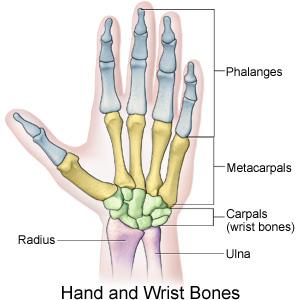
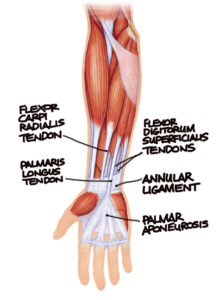
The second illustration above shows the fascia in the wrist area, including tendons of muscles that go all the way up beyond the elbow, and the annular ligament across the wrist. You also see the palmar aponeurosis (analogous to the plantar fascia in the feet), which is tougher fibrous connective tissue protecting the palm of the hand.
When we use our hands to bear our body weight as if they were feet, the wrists are in the extreme position of extension (as in the gesture when you extend your hand forward to say “stop” ). This puts extreme pressure on those eight small bones, and all the soft tissue around them. Without adequate preparation for flexibility and strength in the biomechanics of the arms as a whole, chronic or acute injuries may result.
One particular location to be aware of is the carpal tunnel in the wrist area.
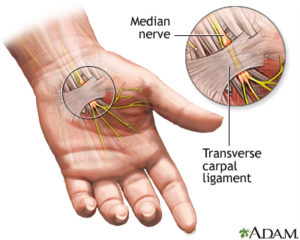
This is the structure formed the carpal bones, which are arranged like a curved roof over a tunnel, whose floor is a broad connective structure called the flexor retinaculum, which is also known as the transverse carpal ligament. When we put excessive pressure on the wrist as in the poses listed above, and the surrounding area is tight or misaligned, the pressure irritates the median nerve inside the tunnel, possibly causing pain, numbness, or dysfunction in the hand.
There are four good ways to avoid this danger that I’ll be covering in this post:
- Loosen the soft tissues of the hands and forearms so there is enough range of motion in the wrists.
- Press down with the fingers to effectively take weight off of the wrists.
- Use supportive pads if necessary.
- Maintain good shoulder alignment.
- Loosening the Soft Tissues of the Hands and Forearms
There are many small muscles of the hands that we use to grasp objects, which are protected by the strong span of connective tissue (shown above) that in itself can be restrictive. Hands that are strong for grasping may not be able to spread enough to become support us in yoga poses. Specific stretching and massage will help to prepare the hands by loosening this soft tissue. Here are examples of some wrist stretches and of massage of the hand with a rubber ball:
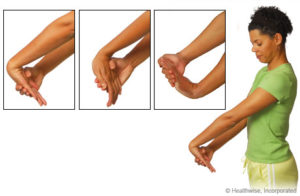
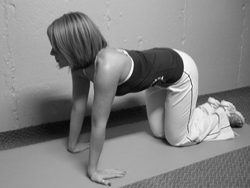
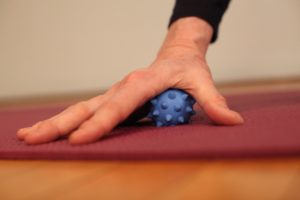

- Pressing Down with the Fingers
When we press the fingers down—all the way to the tips—we transfer weight forward on the hands and reduce the amount of weight on the wrists. Try it right now at your desk: press your fingers down and feel your palms and wrists begin to lift. You can experiment to determine the right amount of this action for you. Use this image with the green and yellow dots as a guide:
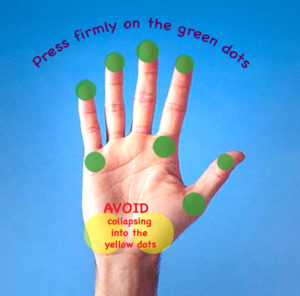
- Using Supportive Pads
You can buy foam wedges to bring the weight forward on the fingers, but I prefer this: Cut up an old sticky mat to make a small roll, as shown here with the pencil as a size comparison.
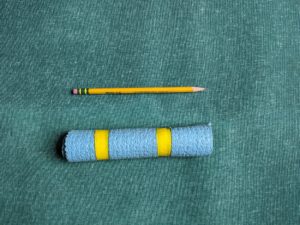
Put that roll under the center of your wrist, pointing it toward and away from your fingertips. It will take pressure off the carpal tunnel and encourage small muscles in your hands to do their work. It’s best to use one under each hand for symmetry, even if only one wrist needs it.
- Aligning Your Shoulders: Upper Back Strengthener and Pectoral Stretch
Shoulder alignment can help to protect the wrists as well. Shoulders that are rounded forward put more weight into the hands. I recommend the pectoral stretch pictured below, plus a strengthening pose to bring your shoulder blades in toward the spine and away from your head. These actions will not only help prevent wrist strain, but it will support your upper spine and your breathing – and also lift your spirits!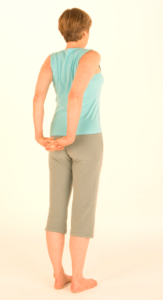
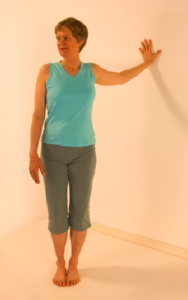

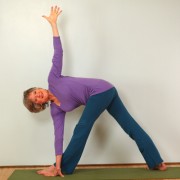
thanks for these reminders